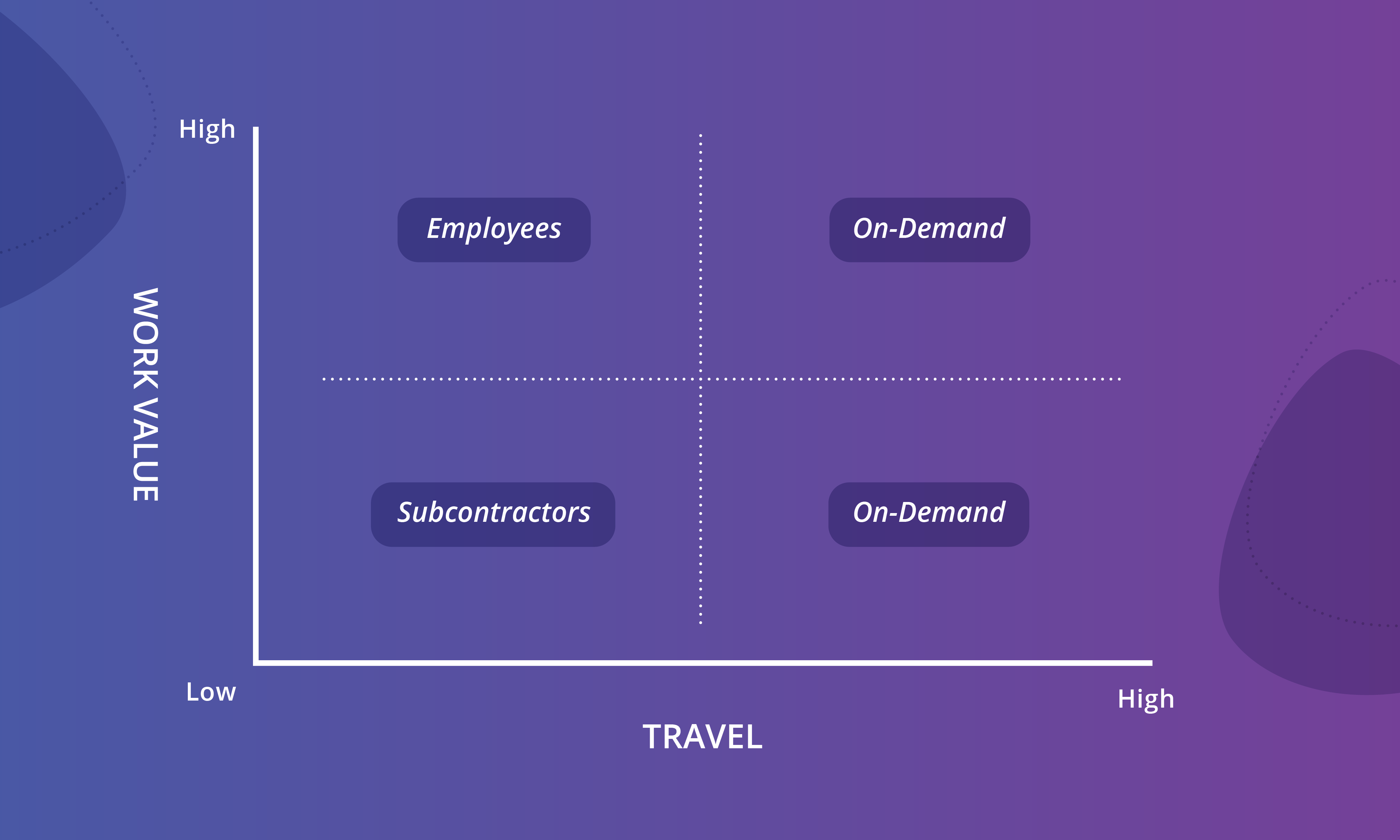
For many service delivery leaders, utilization metrics provide clarity and peace of mind when it comes to the on-the-ground efficiency of their service offerings. But while utilization is an important KPI, it is too often treated as a primary field service success metric that directly reflects profitability.
The reality is much messier.
After all, it’s possible for high utilization rates and low growth rates to coexist, and this fact should concern anyone relying heavily on utilization data. The truth is that high utilization rates can mask other labor inefficiencies that are eating away at your company’s bottom line, and relying too heavily on these metrics can lead to blind spots and profitability issues that undermine your potential for growth.
My goal is to give service delivery leaders a better understanding of a metric problem that is hindering many in the industry – and suggest a few solutions to this problem.
A false sense of security
Let’s say you have a utilization rate of 80%. On average, your field service engineers are spending 80% of their billable hours actively addressing the problems your clients have hired you to solve.
At first glance, this sounds pretty good: Your data tells you that you are maximizing one of your largest costs: your payroll. But upon closer inspection, this number does not (and cannot) highlight meaningful information that may be impacting your bottom line.
Utilization metrics do not (and cannot) highlight meaningful information that may be impacting your bottom line
For example, this utilization rate might not account for extensive travel times that are chipping away at the number of jobs your technicians can work on per day. Additionally, unpredictable customer demand makes resource planning extremely complicated, and this can result in high-value employees handling work that is incommensurate with the fixed cost of their labor. Needless to say, these are massive potential inefficiencies in the delivery process that cannot be captured with utilization.
In this way, because it cannot give you a holistic understanding of factors impacting your bottom line, a high utilization rate is not a reliable metric of success – at least not on its own.
A high utilization rate is not a reliable metric of success – at least not on its own.
Furthermore, the confidence that leadership gets from this high utilization rate can lead to serious profitability issues going unaddressed. In other words, high utilization can lead to a false sense of security.
A $400M MSP’s Profitability Problem
Background: A $400M technology services company we work closely with had a strong backlog and their utilization rate (their primary field service effectiveness measurement) was consistently performing above 85%. Despite all this, they were experiencing profitability issues.
Underlying issues: Our analysis revealed some key problems in the company’s service delivery strategy that were negatively impacting its bottom line.
- Unpredictable customer demand, which made resource planning difficult.
- Extensive travel time, which meant fewer jobs per day per technician.
- Ticket variability, resulting in high-value engineers doing low-skill work.
Our conclusion: The $400M MSP’s focus on utilization as their leading indicator had blinded them to the massive inefficiencies built into their delivery process, leading to poor bottom-line results.
Shifting perspectives
My recommendation is to replace utilization with revenue per day per person as your company’s critical KPI.
Replace utilization with revenue per day per person as your company’s critical KPI.
Doing so moves your company away from looking at service delivery effectiveness solely through a capacity lens and toward a perspective that focuses on delivering results for the business.
Let me explain:
Over the past twenty years, we’ve seen a seismic shift in how companies think about driving revenue. The success of the software as a service (SaaS) recurring revenue model has led other industries to adopt as-a-service offerings, including OEMs who used to make most of their money off the product sale itself. Because they now own the customer outcome, this trend has incentivized more and more organizations to view their service and support teams as mechanisms for growing revenue.
But aiming for revenue growth and integrating that goal into your company’s operational day-to-day are two different things.
In order to promote growth, companies have to align on the outcome they are driving toward, and the starting point on this journey is focusing on the right metric. For service delivery companies, this measurement needs to bring the relationship between their resourcing strategy and their demand into sharper focus.
Most service organizations have significant fixed labor costs and variable revenue, and this mismatch is at the heart of many service organization challenges. But since utilization only focuses on the first part of the equation (the fixed costs), it fails to raise the question of how to successfully align those costs with variable demand.
Revenue per day, on the other hand, encourages you to ask questions about this key alignment.
Asking questions about which engineers are generating the most revenue (and why) highlights opportunities for streamlining labor channels which, in turn, create opportunities for revenue optimization.
For example, how much of your engineer’s time is spent traveling? Can you reduce that?
Are your highly valuable resources spending time on less valuable work? Can you reduce that?
Is there work your team is doing today that could be done by someone else? If so, would this free up your team’s time to do more high-value work?
All of these questions add up to the one question that you might not be asking: Are you using the right ratio of fixed to variable labor?
Putting solutions into practice
Shifts in perspective are one thing. Putting them into action is another. Here is Field Nation’s ROI model designed to emphasize areas that will increase your profitability.

Reduce travel time
It’s time to move beyond route optimization. Instead, move high travel time jobs to an alternate source that’s closer to the job. This minimizes travel expenses and maximizes the revenue that your full-time technicians can generate by increasing the number of high-value jobs they can complete in a day.
Outsource your low-value work
Don’t let low-value jobs decrease your margin by taking up valuable (and expensive) full-time employee time. Outsource these jobs to non-fixed expense talent and let your full-time hires focus on more predictable, higher value, higher revenue work that matches both their skillset and the cost of their technical expertise.
Increase value add
Your engineers are likely the only resources actually interacting with customers. This means that maximizing existing customer value is of the utmost importance. Instead of viewing jobs as mere transactions, frame them as opportunities to be capitalized on. Can your field engineer identify any preventative maintenance needs? Is there additional equipment to be serviced? Can the engineer help to address any gaps in training?
Take a hard look at your company’s ratio between fixed and variable labor
Many of the companies I’ve worked with at Field Nation have struggled with the same fundamental problem: How do I align my resource supply strategy with my demand? The answer, as I see it, is a blended workforce. This addresses the previous three strategies and empowers service delivery leaders to maximize revenue per day by optimizing their labor channels. With the right people, processes, and technology, service leaders are able to deliver significant improvements to revenue per day per employee while also improving overall profitability. And yes, it’ll boost utilization too.
Is utilization dead?
I have a habit of talking about how “utilization is dead,” and that statement tends to turn the heads of service providers. I’ll admit it’s a provocative statement, but in a way, that’s the point. I want service leaders to shift their perspective from inward to outward, from a capacity metric that obscures paths toward growth to a revenue per day metric that centers a service team’s potential for driving revenue while minimizing bottom-line expenses.
The truth is that utilization can still provide very useful information when it comes to understanding your capacity. Still, I think we can all agree that utilization alone does not provide a detailed enough picture when it comes to reducing bottom-line expenses and resolving profitability issues. For that reason, it should not be your sole, go-to KPI.
Service delivery leaders can be primary drivers of revenue, but only if they are heeding the right metrics and making smart decisions when it comes to managing talent.






